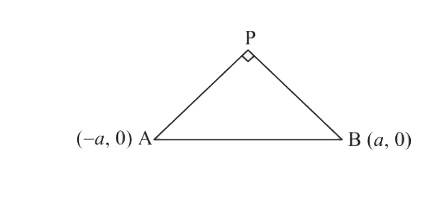A(a,0) , B(-a,0) are two point . If a point P moves such that ∠PAB−∠PBA=2α then find the locus of P .
The correct Answer is:a2
To find the locus of point P such that the condition ∠PAB−∠PBA=2α holds, we can follow these steps:
Step 1: Define Points and Angles
Let the points be defined as follows:
- Point A: A(a,0)
- Point B: B(−a,0)
- Point P: P(x,y)
Step 2: Identify Angles
Let:
- θ1=∠PAB
- θ2=∠PBA
According to the problem, we have:
θ1−θ2=2α
Step 3: Calculate Tangents of Angles
Using the definition of tangent in terms of the coordinates, we can express:
- tan(θ1)=ya−x
- tan(θ2)=yx+a
Step 4: Apply the Tangent Difference Formula
We can use the tangent difference formula:
tan(θ1−θ2)=tan(θ1)−tan(θ2)1+tan(θ1)tan(θ2)
Substituting the values we calculated:
tan(2α)=ya−x−yx+a1+ya−x⋅yx+a
Step 5: Simplify the Expression
Now, we simplify the left-hand side:
tan(2α)=y(1a−x−1x+a)1+y2(a−x)(x+a)
The numerator simplifies to:
y((x+a)−(a−x))(a−x)(x+a)=y(2x)(a−x)(x+a)
Step 6: Set Up the Equation
Now we equate this to tan(2α):
y(2x)(a−x)(x+a)=tan(2α)
Step 7: Rearranging Terms
Cross-multiplying gives:
2xy=tan(2α)⋅((a−x)(x+a))
Expanding the right-hand side:
2xy=tan(2α)⋅(a2−x2)
Step 8: Final Locus Equation
Rearranging the equation leads to:
2xy−tan(2α)x2+tan(2α)a2=0
This can be rewritten as:
x2tan(2α)+2xy=a2tan(2α)
Final Answer
Thus, the locus of point P is given by:
x2−a2tan(2α)+2xy=0
Let the points be defined as follows:
- Point A: A(a,0)
- Point B: B(−a,0)
- Point P: P(x,y)
Let:
- θ1=∠PAB
- θ2=∠PBA
θ1−θ2=2α
Using the definition of tangent in terms of the coordinates, we can express:
- tan(θ1)=ya−x
- tan(θ2)=yx+a
We can use the tangent difference formula:
tan(θ1−θ2)=tan(θ1)−tan(θ2)1+tan(θ1)tan(θ2)
Substituting the values we calculated:
tan(2α)=ya−x−yx+a1+ya−x⋅yx+a
Now, we simplify the left-hand side:
tan(2α)=y(1a−x−1x+a)1+y2(a−x)(x+a)
The numerator simplifies to:
y((x+a)−(a−x))(a−x)(x+a)=y(2x)(a−x)(x+a)
Now we equate this to tan(2α):
y(2x)(a−x)(x+a)=tan(2α)
Cross-multiplying gives:
2xy=tan(2α)⋅((a−x)(x+a))
Expanding the right-hand side:
2xy=tan(2α)⋅(a2−x2)
Rearranging the equation leads to:
2xy−tan(2α)x2+tan(2α)a2=0
This can be rewritten as:
x2tan(2α)+2xy=a2tan(2α)
Thus, the locus of point P is given by:
x2−a2tan(2α)+2xy=0
Similar Questions
A (a,0) , B (-a,0) are two points . If a point P moves such that ∠PAB−∠PBA=π/2 then find the locus of P.
View SolutionA (c,0) and B (-c,0) are two points . If P is a point such that PA + PB = 2a where 0<c<a, then find the locus of P.
View SolutionA(1,1) , B (-2,3) are two points . If a point P forms a triangle of are 2 square units with A, B then find the locus of P.
View SolutionA(5,3) B (3,-2) are two points . If a point P forms a triangle of area 9 square units with A,B then find the locus of P.
View SolutionA(2, 0) and B(4, 0) are two given points. A point P moves so that P A 2 + P B 2 = 10 . Find the locus of P.
View SolutionA(2,3) B (-3,4)are two points P moves such that the area of ΔPAB is 8.5 square units, then find the locus of P
View SolutionA(2,3),B(1,5),C(−1,2) are the three points . If P is a point such that PA2+PB2=2PC2, then find locus of P.
View SolutionA(2, 0) and B(4, 0) are two given points. A point P moves so that PA2+PB2=10. Find the locus of P.
View SolutionA and B are two fixed points. The locus of a point P such that ∠APB is a right angle, is:
 View Solution
View SolutionThe coordinates of the point A and B are (a,0) and (−a,0), respectively. If a point P moves so that PA2−PB2=2k2, when k is constant, then find the equation to the locus of the point P.
View Solution

